Real Science- 5 Incredible Facts about Calendula
This entry was posted on January 16, 2017.
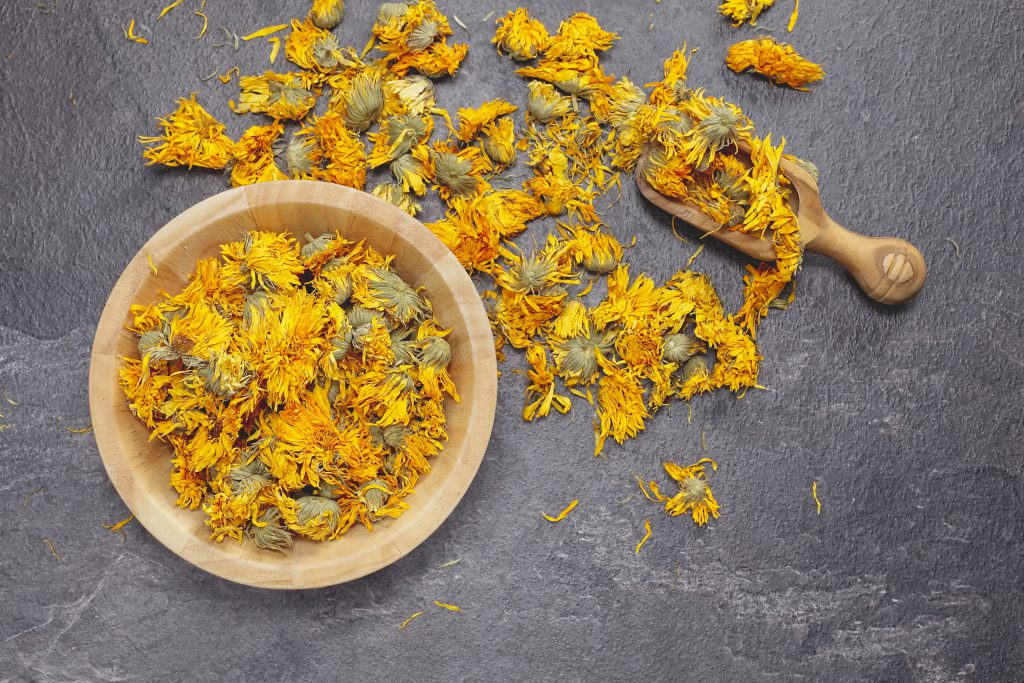
Calendula Officinalis is an amazing plant. Known commonly as Potted Marigold, the marigold, or simply Calendula, it has wondrous properties that have been utilized as herbal remedies for hundreds of years. Currently, new scientific testing has confirmed many of these beliefs about Calendula and its pharmacological properties. The extract has flavonoids, saponins, and polysaccharides that have all been shown to have some positive effects. Different medical experiments have taken the extracts from the plant to try to isolate the positive effects.
Skincare Help during Radiation Treatment
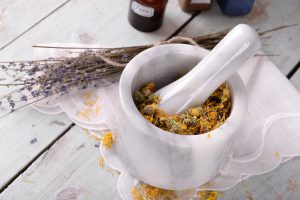 Different dried herbs and mortar on table close up
Different dried herbs and mortar on table close upFor women undergoing radiation treatment for breast cancer, there has always been a desire to have a preventive topical cream that could help reduce the dermatological effects. Specifically, doctors wanted something that could reduce acute dermatitis during these periods. For a long time, the only available option was a topical cream with Trolamine. A study in the Journal of Clinical Oncology was designed to test a topical cream made from the extract of Calendula Officinalis and the cream made from Trolamine. The findings were astounding. Across the board, the Calendula extract cream was superior. The number of patients exhibiting grades two or three skin toxicity was significantly lower in the group administered the Calendula extract in a statistically significant way (P<.001). Additionally, these patients reported less discomfort, and had fewer instances of suspension of therapy due to skin toxicity. All of this combines to show that early medical practitioners were certainly on to something. This is good evidence that Calendula has positive effects on the skin. This scientific study shows that, during radiation treatment, Calendula can be greatly helpful in reducing skin problems. There is also an implication that, as a whole, Calendula has some powerful properties for dermatological care.
http://ascopubs.org/doi/full/10.1200/jco.2004.07.063
Help for Cuts or Wounds
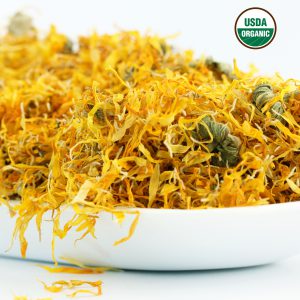
Calendula has often been used as a do it yourself salve or wound cover. This has been a practice spanning hundreds of years, but they are beginning to find evidence that this has verifiable scientific results. In a study done on laboratory rats, calendula extract was tested in wounds. These animals were given induced wounds, and some were treated with calendula officinalis extract. What they found was that the animals given the extract showed marked improvements in regeneration and epithelialization. The scientist working on the study believe the effect is a result of intensified metabolism of glycoproteins nucleoproteins, and collagen proteins during tissue regeneration. This study was published in the Acta Physiologica et Pharmacologica Bulgarica.
http://europepmc.org/abstract/med/7185264
Anti-Inflammatory and Anti-Tumor Properties
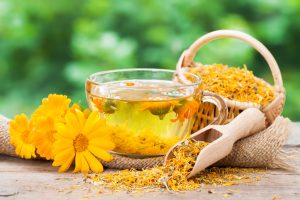 Cup of healthy marigold tea and calendula flowers.
Cup of healthy marigold tea and calendula flowers.This study was published in the Journal of Natural Products. It was carried out by several Japanese professors, and was to look at specific chemical compounds found in Calendula Officinalis and what those effects are. Ten oleanane-type triterpene glycosides were examined for this study along with five known flavonol glycosides. All of these were compounds found and extracted from the Calendula Officinalis family. Eight of the compounds showed a marked anti-inflammatory property. 10 of the compounds showed moderate inhibitory effects on a virus. And lastly, two of the compounds showed potent cytotoxic effects against a variety of cancer cells. These tests are still in the early stages, but are certainly promising for the future medical benefits of Calendula.
http://pubs.acs.org/doi/full/10.1021/np068016b
Anti-Fungal Properties
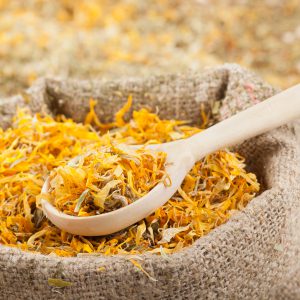 sack of healing herbs and wooden scoop, herbal medicine
sack of healing herbs and wooden scoop, herbal medicineA study published in the Brazilian Journal of Microbiology sought to examine the effects of essential oils created from Calendula on fungus. They distilled the essential oils and then injected them into several different testing specimens. The test was done using 23 different fungi strains, and the essential oil was found to be effective at reducing fungi for all 23 strains. This is a preliminary study, and clearly more work needs to be done, but this is a good sign for those that claim antifungal properties are associated with Calendula.
http://www.scielo.br/scielo.php?pid=S1517-83822008000100015&script=sci_arttext&tlng=e!n
Acne Help
A study done in the International Journal of Pharmacy and Biology examined the ways that Calendula helps acne. Interestingly, it found that many of the properties discussed above (anti-inflammatory, anti-fungus, etc) work in conjunction to have a product that helps reduce acne. Many of these effects were due to the variety of flavonoids present in Calendula. By reducing inflammation and keeping out fungus, it is not surprising that Calendula would be helpful in treating and preventing acne.
Conclusion
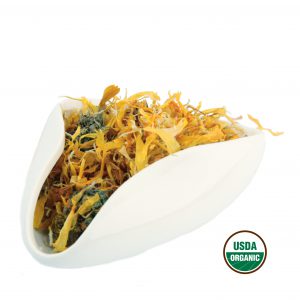 The pot marigold has long been thought of to have powerful medicinal properties. For years these ideas were left to mystics and non-western healers. The tide is turning, as many within the medical community are turning towards herbal remedies to avoid the rising tide of prescription drugs. This organic solution is
The pot marigold has long been thought of to have powerful medicinal properties. For years these ideas were left to mystics and non-western healers. The tide is turning, as many within the medical community are turning towards herbal remedies to avoid the rising tide of prescription drugs. This organic solution is
starting to be studied more closely, and the results are confirming what many already thought: Calendula is a powerful flower with many positive effects on the body. Here at U.S. Wellness we offer Calendula flowers that are perfect for distilling into essential oils, making into tea, or even using for topical creams. Buy some today and experience the wonderful benefits of this all natural remedy.



There are a lot of commercial extracts of calendula being sold online. I am using moogoo for my little infant son's eczema and guess what? It worked better for his sister but not so much for him:). I like that you stick to the science, that is the only way othervise pretty soon calendula will be used for time-travel.